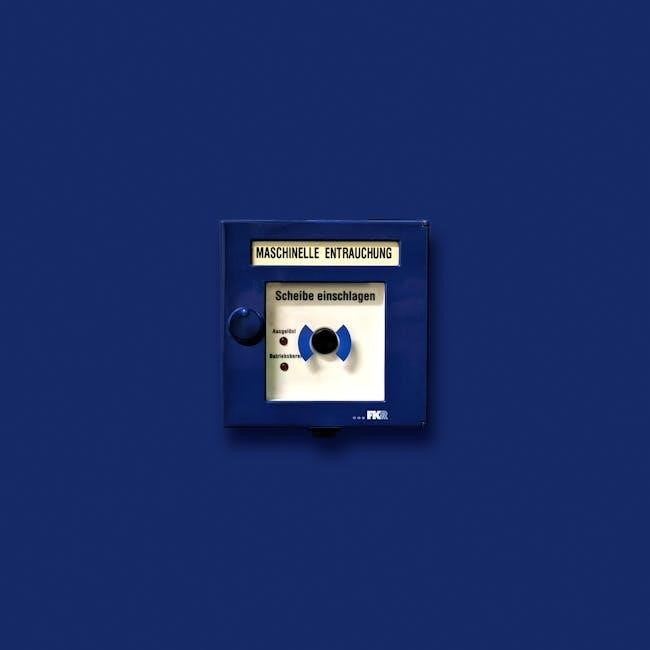Kidde Nighthawk Carbon Monoxide Alarm manual provides guidance on installation, operation, and maintenance of the device, ensuring user safety and compliance with regulations, using digital display and battery backup features always.
Overview of the Kidde Nighthawk Carbon Monoxide Alarm
The Kidde Nighthawk Carbon Monoxide Alarm is a device designed to detect carbon monoxide from any source of combustion, providing a digital display and battery backup for continuous monitoring. This alarm is not intended to detect smoke, fire, or other gases, and is not suitable for installation in hazardous locations as defined in the National Electric Code. The device is powered by a 120VAC, 60 Hz source along with a 9V battery backup, ensuring uninterrupted operation. The Kidde Nighthawk Carbon Monoxide Alarm features a temperature operating range of 40F to 100F and a humidity operating range of 5 to 95 relative humidity, making it suitable for various environments. The alarm is attached to a mounting plate and can be removed by turning it counterclockwise, allowing for easy installation and maintenance. Overall, the Kidde Nighthawk Carbon Monoxide Alarm is a reliable and efficient device for detecting carbon monoxide, providing users with peace of mind and protection from potential hazards. The device’s digital display and battery backup features ensure continuous monitoring and alert users in case of an emergency.

Importance of Reading the Manual
Reading the manual is crucial for proper installation and operation of the Kidde Nighthawk Carbon Monoxide Alarm, ensuring user safety and compliance with regulations always and correctly.
Understanding the Kidde Nighthawk Carbon Monoxide Alarm Features
The Kidde Nighthawk Carbon Monoxide Alarm has several key features that make it an effective and reliable device for detecting carbon monoxide in the home. One of the main features is its digital display, which shows the level of carbon monoxide in the air. This allows users to quickly and easily see if there is a problem. The alarm also has a battery backup, which ensures that it will continue to function even in the event of a power outage. Additionally, the device is powered by a 120VAC, 60 Hz source, making it easy to install and use. The temperature operating range is between 40F and 100F, and the humidity operating range is 5-95 relative humidity, making it suitable for use in a variety of environments. Overall, the Kidde Nighthawk Carbon Monoxide Alarm is a sophisticated device that is designed to provide accurate and reliable detection of carbon monoxide. Its features make it an excellent choice for homeowners who want to ensure their safety and the safety of their families. The device is also easy to use and maintain, with a simple and intuitive interface.

Installation and Mounting of the Kidde Nighthawk Carbon Monoxide Alarm
Installation requires attaching to a mounting plate, following manufacturer instructions carefully always.
Removing the Kidde Nighthawk Carbon Monoxide Alarm from the Mounting Plate
To remove the Kidde Nighthawk Carbon Monoxide Alarm from the mounting plate, turn the alarm counterclockwise. This will release the alarm from the plate, allowing for removal and maintenance. The process is straightforward and requires no special tools. It is essential to follow the manufacturer’s instructions for removal to avoid damaging the alarm or the mounting plate. The alarm can be removed for various reasons, including maintenance, testing, or replacement of batteries. Always refer to the user manual for specific instructions on removing the Kidde Nighthawk Carbon Monoxide Alarm from the mounting plate. By following the correct removal procedure, users can ensure the alarm continues to function correctly and provide reliable protection against carbon monoxide. Regular maintenance and testing are crucial to ensure the alarm remains in good working condition. The removal process is a critical step in maintaining the alarm’s effectiveness.
Technical Specifications of the Kidde Nighthawk Carbon Monoxide Alarm
Specifications include operating temperature and humidity range, power source, and sensor type, ensuring proper function and accuracy always with digital display features included in the device.
Operating Temperature and Humidity Range of the Kidde Nighthawk Carbon Monoxide Alarm
The Kidde Nighthawk Carbon Monoxide Alarm is designed to operate within a specific temperature and humidity range, ensuring optimal performance and accuracy. The operating temperature range is between 40F and 100F, which is equivalent to 4C and 38C. This range allows the alarm to function properly in most indoor environments. The humidity operating range is between 5 and 95 relative humidity, which is a fairly wide range that can accommodate various indoor conditions. It is essential to ensure that the alarm is installed and operated within these specified ranges to guarantee reliable detection of carbon monoxide.

Maintenance and Testing of the Kidde Nighthawk Carbon Monoxide Alarm
Regular testing and maintenance of the alarm is crucial for ensuring proper function and safety always using digital display features.
Troubleshooting Common Issues with the Kidde Nighthawk Carbon Monoxide Alarm
Troubleshooting common issues with the Kidde Nighthawk Carbon Monoxide Alarm is essential for ensuring the device functions properly and provides accurate readings. The manual provides guidance on resolving issues such as faulty sensors, low battery warnings, and incorrect installation; Users can refer to the troubleshooting section to identify and fix problems, minimizing downtime and ensuring continuous protection. By following the troubleshooting steps, users can quickly resolve issues and restore the alarm to working order. The Kidde Nighthawk Carbon Monoxide Alarm manual also provides information on error codes and their meanings, allowing users to diagnose and fix problems efficiently. Regular troubleshooting and maintenance can help extend the life of the device and ensure it continues to provide reliable protection against carbon monoxide poisoning. Users should always refer to the manual for guidance on troubleshooting and maintenance to ensure the alarm functions correctly and provides accurate readings.

